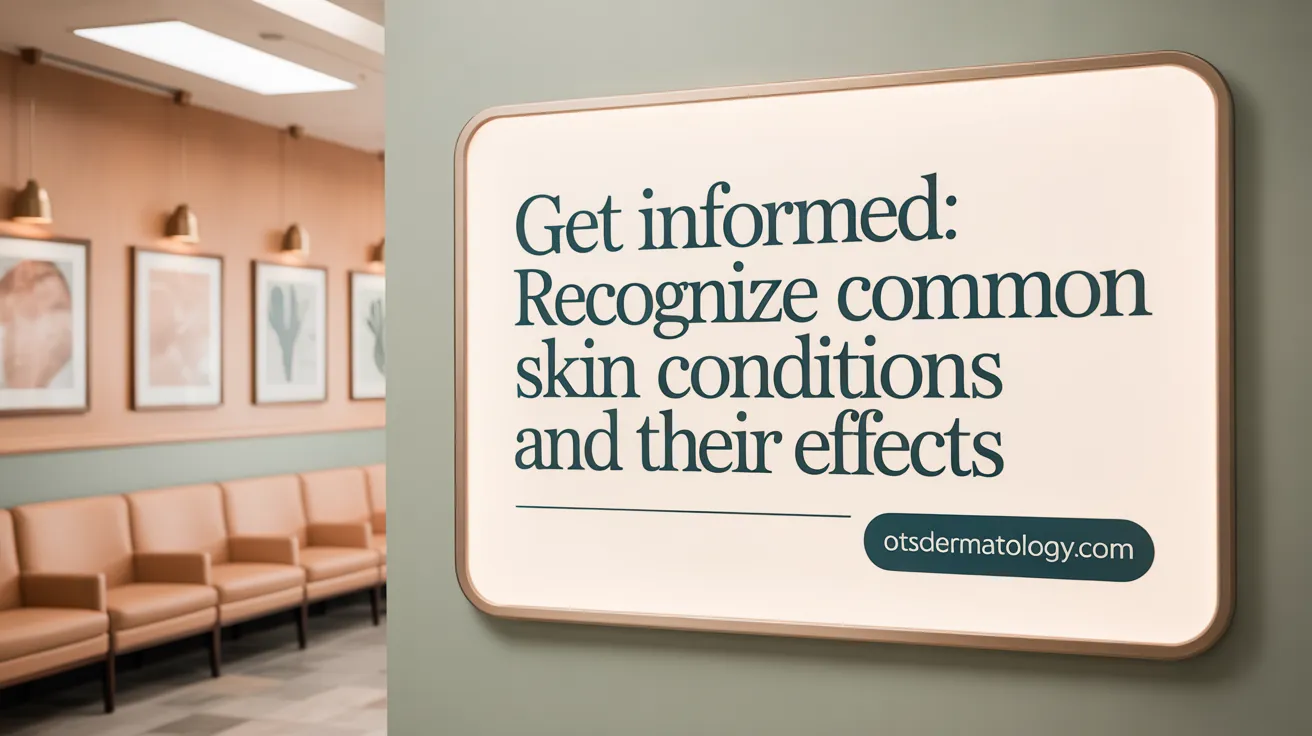Why Patient Experience in Dermatology Is Crucial
The field of dermatology extends far beyond treating skin conditions; it encompasses protecting the body's largest organ and significantly impacts patients' quality of life. Understanding the patient experience is vital for dermatologists to provide effective care, improve outcomes, and increase patient satisfaction. This article explores key aspects your dermatologist wishes you knew—from communication to treatment expectations, and preventive care to navigating the healthcare system.
The Vital Role of Effective Communication in Dermatology Care

Why is communication important in dermatology?
Effective communication between dermatologists and patients is crucial for successful management of skin conditions. It fosters trust, improves patient understanding, and enhances adherence to treatments, all of which contribute to better clinical outcomes. Given that many skin diseases require ongoing care, clear dialogue helps address patient concerns, reduce anxiety, and clarify treatment goals.
How does communication impact patient satisfaction?
Research consistently shows that patients value thorough examinations and responsiveness. High-quality communication correlates with greater patient satisfaction, which in turn positively influences treatment adherence and retention. Patients who feel heard and involved in decision-making are more likely to continue care and report better experiences.
What communication skills training benefits dermatologists?
Workshops using simulated patient interactions provide dermatologists with constructive feedback and help improve skills such as empathy, listening, explaining diagnoses, and managing patient emotions. These sessions focus on areas like allowing patients to share their story fully and ensuring patient understanding, as seen in Simulation-Based Workshops for Dermatologists.
How do preconsultation questionnaires help?
Using simple questionnaires before appointments allows dermatologists to gauge patient knowledge, fears, and expectations. This aids in tailoring communication to address patients’ specific concerns, improving engagement and satisfaction as described in research on doctor–patient communication and preconsultation questionnaires in dermatology.
What role does the doctor–patient relationship play?
A strong relationship built on respect, clear communication, and shared decision-making enhances satisfaction and clinical success. Small actions like sitting during consultations and avoiding interruptions make patients feel valued and supported, thereby strengthening this relationship and contributing to improving patient satisfaction and clinical ratings.
Understanding Your Skin: Common Conditions and Their Impact

Common Skin Diseases and Their Symptoms
Skin diseases affect millions and can cause various symptoms like rashes, inflammation, dry patches, and bumps. Common conditions include acne, eczema (especially atopic dermatitis), psoriasis, rosacea, and hair loss such as androgenetic alopecia. These diseases vary widely but often share signs such as skin discoloration, peeling, or itching. For a comprehensive overview, see Skin Diseases Overview.
Treatments and Management
Treatment depends on the condition and may involve medicated creams, oral medications, antibiotics, or surgical procedures like biopsies or mole removals. Chronic diseases such as psoriasis and eczema require ongoing care and sometimes systemic therapies. Dermatologists emphasize lifestyle adjustments like proper skin care, stress management, avoiding irritants, and sun protection to help manage symptoms effectively. More about managing chronic skin disease is available.
Skin Cancer Awareness and Early Detection
Skin cancer is a major health concern with types including basal cell carcinoma, squamous cell carcinoma, and melanoma, linked strongly to ultraviolet exposure. The importance of early detection cannot be overstated—when diagnosed early, survival rates for melanoma reach 99%. Regular full-body skin exams by a dermatologist especially for changing moles or unusual spots are vital. Additional resources on skin cancer prevention and awareness provide valuable information.
Managing Chronic Skin Conditions
Chronic skin issues such as psoriasis and eczema affect millions, impacting quality of life and requiring strategies including regular medical follow-ups, symptom monitoring, and access to emerging therapies. Collaborative care between patients and dermatologists improves control over these conditions. Explore more on managing psoriasis effectively and integrated patient care through patient-reported outcomes.
By understanding common skin conditions, their signs, and the importance of skin cancer screening, patients can participate actively in maintaining skin health and seek timely medical advice when needed. Additional tips and top health tips from dermatologists can help guide everyday skin protection and care.
Sunscreen and Sun Safety: The Foundation of Skin Health
How does sunscreen help prevent skin cancer?
Skin cancer is largely caused by excessive exposure to ultraviolet (UV) rays from the sun and tanning beds. These rays damage the DNA in skin cells, potentially leading to basal cell carcinoma, squamous cell carcinoma, and melanoma. Using sunscreen daily reduces this risk significantly by blocking UV radiation before it harms the skin. Learn more about risks of ultraviolet exposure and skin cancer detection and treatment.
What kind of sunscreen is recommended?
A broad-spectrum sunscreen with an SPF of 30 or higher is advised by dermatologists. "Broad-spectrum" means it protects against both UVA rays, which penetrate deeply and cause aging and DNA damage, and UVB rays, which cause sunburns. Mineral sunscreens containing zinc oxide or titanium dioxide are preferred for sensitive skin, as they physically reflect UV rays. See details about broad-spectrum sunscreen importance and using SPF 30 or higher.
How should sunscreen be applied and reapplied?
Proper application is crucial to achieve protection. Use about a teaspoon for the face and a shot glass amount for the full body. Apply sunscreen evenly to all exposed areas, including often-missed spots like ears, neck, scalp, backs of hands, and tops of feet. Sunscreen should be reapplied every two hours or after swimming, sweating, or towel drying. Water-resistant sunscreens protect for 40 to 80 minutes in water but still require reapplication. For comprehensive sun safety tips for summer and proper sunscreen application, refer to expert guidelines.
What other sun safety measures complement sunscreen use?
Sunscreen should be part of a broader sun safety routine. Wearing protective clothing, hats, and UV-blocking sunglasses provides physical barriers. Seeking shade, especially during peak sun hours (10 a.m. to 4 p.m.), limits UV exposure. Combining these approaches offers the best defense against skin damage. Additional advice on skin protection and regulation and sun protection offers useful insights.
Are there myths about sun protection to be aware of?
Some believe a "base tan" protects from sunburn, but a tan provides minimal SPF 4 protection and does not prevent DNA damage. Also, SPF 100 offers only a fraction more protection than SPF 30, so consistently reapplying sunscreen is more important than relying on higher SPF values alone. Tanning beds emit harmful UVA rays and increase skin cancer risk. Understand the dangers of tanning beds and SPF facts to avoid common misconceptions.
Implementing these sun safe habits preserves the skin’s vital roles—including protection and regulation—and significantly lowers the chances of developing skin cancer and premature aging. For more information on healthy skin functions and early detection and treatment of skin cancer, consult dermatologist-reviewed resources.
Navigating Dermatology Visits: Preparation and Practical Tips
How do I choose the right dermatologist?
Selecting a board-certified dermatologist ensures specialized expertise; look for credentials such as FAAD (Fellow of the American Academy of Dermatology) (Choosing a board-certified dermatologist). Consider their specialization—whether medical, cosmetic, or surgical dermatology—to match your personal skin concerns (Choosing a board-certified dermatologist). Patient reviews can offer insights but always verify their authenticity (Choosing a board-certified dermatologist. Comfort levels, including gender preferences and language capabilities, may affect treatment satisfaction and communication (Dermatologist demographics and Patient satisfaction).
What should I do to prepare for my dermatology appointment?
Before your visit, document your symptoms, skincare routines, and any medications (What is a dermatologist). Remove makeup, nail polish, and refrain from heavy skin treatments (Skin cancer screening tips). Bringing medical records or previous biopsy results can expedite diagnosis, especially for skin cancer screening (Skin cancer screening. Preparing questions and concerns ahead of time facilitates effective communication and maximizes consultation benefits (Effective Communication Techniques for Dermatologists).
How does insurance affect dermatology care?
Check with your dermatologist's office on insurance acceptance to prevent unexpected costs (Choosing a board-certified dermatologist. Know that some procedures (e.g., steroid injections, surgeries) are covered if medically necessary (Insurance prior authorization delays). Be aware that prior authorization processes may delay treatments—advocate for timely care if needed (Advocating for timely dermatologic care.
What influences the clinic experience and patient satisfaction?
Timely appointments, respectful staff, and clear communication significantly increase satisfaction (Patient satisfaction in dermatology). Spending adequate time during consultations and involving patients in decision-making improves outcomes (Patient-reported outcomes in dermatology). Patient satisfaction impacts compliance and retention, so expressing feedback helps clinics improve services (Assessment of Patient Satisfaction).
How can patients be more involved in their dermatology care?
Engage actively—use preappointment questionnaires to clarify fears and expectations (doctor–patient communication in dermatology). Ask about treatment options, product ingredients, and sun protection measures (Skin care questions for your dermatologist). Understanding your condition and collaborating with your dermatologist promotes better health outcomes (American Academy of Dermatology).
Patient-Centered Outcomes and Satisfaction: Measuring Quality in Dermatology

Why Is Patient Satisfaction Important in Dermatology?
Patient satisfaction plays a vital role in dermatology as it directly influences clinical outcomes and patient retention. Satisfied patients tend to be more compliant with treatments, which improves management of chronic skin conditions. Conversely, dissatisfied patients are more likely to seek care elsewhere and may be prone to file malpractice claims. Due to these factors, patient satisfaction serves as a proxy for quality clinical care and impacts both clinical reputations and reimbursement incentives. For more details, see Patient satisfaction in dermatology.
What Are Patient-Reported Outcomes (PROs) and Their Role?
Patient-reported outcomes (PROs) are measures that capture patients' perspectives on their health status, treatment satisfaction, symptom burden, and quality of life. In dermatology, tools like the Dermatology Life Quality Index (DLQI) and Skindex are used to collect this data. PROs enhance patient-centered care by actively engaging patients in treatment decisions and tailoring therapies to individual needs, leading to improved treatment effectiveness and holistic care. Learn more about Role of Patient-Reported Outcomes in Dermatology.
How Do Dermatologists Use Quality Improvement Methods?
Quality improvement (QI) systems involving patient satisfaction surveys help dermatologists identify areas needing enhancement. For example, the DrScore online system provides cost-effective access to patient satisfaction data, motivating staff improvement and helping fulfill continuing education requirements. Commonly targeted areas for improvement include communication, follow-up processes, and increasing time spent with patients. Implementing these changes can elevate overall care quality and patient experience. See Assessment of Patient Satisfaction for more information.
Do Patient Demographics Affect Satisfaction Scores?
Patient satisfaction is influenced by fixed factors such as age, race, health status, and practice setting. Research shows language differences may affect satisfaction, with Spanish-speaking patients reporting lower scores in some domains. However, studies found no consistent evidence that dermatologist gender significantly affects patient satisfaction. Understanding these demographic influences helps practices tailor strategies for equitable care. For study insights, refer to Dermatologist demographics and patient satisfaction.
How Is Patient Feedback Collected and Used?
Feedback is gathered through patient satisfaction questionnaires, surveys like CAHPS, and emerging digital tools integrated into electronic health records. This data highlights strengths and exposes weaknesses in care delivery. Providers can then address concerns such as staff responsiveness, scheduling convenience, and communication clarity. Continuous feedback loops promote sustained quality improvements and foster stronger patient-physician relationships. For deeper understanding, visit Improving Patient Satisfaction in Dermatology Clinics.
Advances in Dermatology Care and Patient Experience Enhancements

What are some innovative treatments and procedures in dermatology?
Modern dermatology offers a range of innovative treatments aimed at improving skin health and appearance. Procedures include microneedling enhanced with radio-frequency and platelet-rich plasma (PRP) to stimulate collagen for skin rejuvenation. Laser therapies, both ablative and nonablative, serve for skin resurfacing, acne scar treatment, pigmentation reduction, and hair removal. These techniques provide gradual, natural-looking results, often lasting years with consistent care. Moreover, minimally invasive treatments like neuromodulators and dermal fillers are widely used to address aging signs and volume loss. For more details, see cosmetic dermatology procedures.
How important is communication in cosmetic dermatology?
Effective communication in cosmetic dermatology centers on assertiveness, empathy, and critical judgment. Good dialogue enables clear setting of patient expectations and enhances their experience. Dermatologists use visual aids such as before-and-after photos to motivate patients and clarify treatment benefits. Simplifying medical language and encouraging questions ensure patients understand procedures and care instructions, fostering trust and satisfaction. Learn more about key communication skills in cosmetic dermatology and effective communication techniques for dermatologists.
What new methods are improving wound closure?
Innovative wound closure devices like microMend use stainless steel microstaples arranged in a butterfly shape. This method is as effective as traditional sutures or staples but is painless to apply and remove, requires no clinical expertise, and reduces follow-up visits. microMend adapts elastically to skin movement, is hypoallergenic, and has demonstrated better cosmetic outcomes with less inflammation and scarring. Detailed information is available at microMend butterfly-shaped bandage.
How are telemedicine and digital tools enhancing dermatologic care?
Telemedicine and digital platforms increase patient engagement by providing accessible health information and remote consultation possibilities. Tools like the DrScore system collect patient satisfaction data, helping dermatologists improve service quality. Digital communication channels also facilitate real-time patient-reported outcomes (PROs), which guide personalized treatment plans. Furthermore, employee-facing digital signs in practice settings promote better staff communication and reduce burnout, indirectly benefiting patient care. For further insight see Patient satisfaction in dermatology, role of patient-reported outcomes in dermatology, and engaging dermatologists with internal digital signs.
What role does continuing education play for dermatologists in improving patient experience?
Continuing education, including workshops with standardized patient simulations, improves dermatologists' communication skills, contributing to better patient satisfaction and treatment adherence. Programs emphasize areas needing growth, such as eliciting patient narratives and managing emotions. Such training aids dermatologists in delivering empathetic, thorough care, addressing patients' fears and expectations effectively. Ongoing education ensures clinicians stay updated with emerging treatments and communication strategies, leading to higher-quality, patient-centered care. For more information, see simulation-based workshop for dermatologists and Dermatologists communication skills.
Building Strong Patient-Dermatologist Relationships for Better Outcomes

Why Are Trust and Empathy Important in Dermatology?
Trust and empathy form the foundation of a strong relationship between patients and dermatologists. Patients value respectful and compassionate communication, which makes them feel understood and cared for. This emotional connection fosters greater satisfaction and openness during consultations, essential for managing chronic skin diseases effectively (Improving patient satisfaction, clinical ratings enhancement, and effective patient interactions in dermatology).
How Does Time Spent Affect Patient Satisfaction?
Spending adequate time with patients allows dermatologists to thoroughly examine skin conditions and address concerns. Patients report higher satisfaction when doctors listen carefully and do not rush, as this helps in setting realistic treatment goals and managing expectations (Patient satisfaction in dermatology and importance of physician interpersonal skills).
How Does Open Dialogue Improve Care?
Encouraging an open dialogue creates space for patients to share fears and expectations. Clear communication helps clarify treatment plans, enabling patients to participate actively. This leads to improved understanding, trust, and adherence to prescribed therapies (Communication Behaviors Valued by Dermatology Patients and Improving Physician Training in Dermatology Communication).
What Role Do Staff-Patient Dynamics Play?
Positive interactions with clinic staff significantly influence overall patient experience. Friendly, helpful, and efficient staff reduce patient anxiety and contribute to a welcoming environment, supporting continuity and quality of care (Patient-physician relationship and staff satisfaction in healthcare.
How Does a Strong Relationship Affect Treatment Adherence?
A trusting patient-dermatologist relationship correlates with better adherence to treatment regimens. Patients who feel heard and involved in decision-making are more likely to follow instructions, resulting in better management of skin conditions and improved health outcomes (Role of Patient-Reported Outcomes in Dermatology Enhancing Patient-Centered Care.
Putting Patients First: The Future of Dermatology Care
Patient experience is a cornerstone of effective dermatologic care. By fostering transparent communication, promoting education on skin health, improving clinic environments, and embracing patient-centered approaches, dermatologists can enhance satisfaction and outcomes. Patients, empowered with knowledge and clear expectations, can actively participate in their care, leading to stronger partnerships and healthier skin. As dermatology continues to evolve with innovative treatments and technologies, prioritizing the patient perspective remains essential for advancing quality care and wellbeing.
